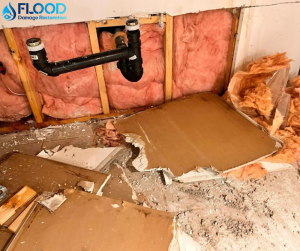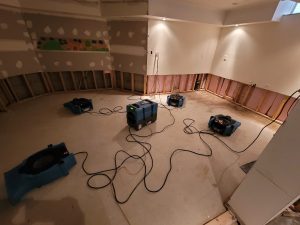Contact Us Now: (416) 648-2895
Need Flood Restoration Services?
Call us Now, and help will be on the way!

Understanding Basement Flooding Risks
For homeowners in Toronto, basement flooding risks are a common concern because they may result in significant damage and disruption. Homeowners need to be proactive in protecting their properties from this persistent hazard even while the city works hard to improve its basement drainage systems. All homes, no matter how old, run the risk of having a flooded basement, especially in the event of a lot of rain or quick snowmelt.
Common Causes of Basement Flooding
Understanding the root causes of basement flooding is crucial to taking effective action against it. These may consist of:
Drainage Failures
- Water seepage is caused by leaks or cracks in the basement walls, doors, windows, or foundations.
- Poor lot grading or drainage, causes water to build up around the house.
- A sump pump malfunction or a breakdown of the weeping tile system.
- Blocked or leaking downspouts.
Sewer Backups
- Sewer line blockage that allows water to backflow into the property.
- Tree roots that might be crowding the sewer systems and causing obstructions.
Overland Flooding
- Stormwater or groundwater enters the property as a result of improper catch basin maintenance or drainage.
- Water accumulation brought on by snowmelt or strong rains, made worse by poor drainage or grading.
Determining the cause of the flooding in your basement is essential to putting preventative and remediation measures in place.
Immediate Actions in Case of a Flooded Basement
If your basement has already flooded, it is essential to act quickly to minimize further damage and ensure your safety. Here are the immediate steps you should take:
Prioritize Safety
- To avoid potential electrical hazards or electrocution, contact Toronto Hydro right away to have your electricity off if water has risen above outlets or close to the electrical panel.
- Use of sinks and toilets should be avoided unless required until the problem is fixed if you suspect a sewage backup since this could worsen the flooding.
- If you smell gas, leave the flooded area right away since the water might put out a pilot light, which could be dangerous.
Document the Damage
- Take photographs and videos of the flooded area and any damaged belongings for insurance claims purposes.
- Keep receipts for any emergency repair or flood cleanup work you undertake.
Contact Your Insurance Provider
- Notify your insurance company as soon as possible and report the property damage caused by the flooding.
- Your insurance provider will guide you through the claims process and advise on the necessary steps.
Begin Cleanup
- If it is safe to do so, start the flood clean-up services process by removing standing water using a pump or wet-dry vacuum.
- Use fans and drying equipment to aid in drying out the affected area.
Remember, your safety should always be the top priority. If the situation is unsafe or you are unsure of how to proceed, it is best to seek professional assistance.
Assessing and Addressing Basement Flooding Damage
Once the immediate crisis has been addressed, it is crucial to assess the extent of the damage and take steps to prevent future occurrences. Here’s what you should do:
Consult Professionals
- Hire a certified plumber to examine and fix any plumbing problems, such as burst pipes or malfunctioning sump pumps, that might have led to the flooding.
- Hire a structural expert to inspect your basement and find any hidden structural integrity problems that require attention.
Cleanup and Restoration
- Completely dry the affected area within 24 to 48 hours of the flooding and clean it with the proper disinfectants for mold prevention.
- If there are contents from the basement or area that cannot be saved, including wet flooring, drywall, or insulation, discard them and replace them with waterproof or water-resistant materials.
- Incorporate flood protection systems like sump pumps and drainage systems into the renovation and repair of your basement by working with experienced flood restoration companies.

Long-Term Basement Flood Prevention Strategies
While addressing the immediate aftermath of a basement flood is crucial, implementing long-term prevention strategies is equally important to safeguard your home from future incidents. Here are some effective measures to consider:
Install a Sump Pump
Sump pumps are an invaluable tool for keeping your basement dry. They collect and remove excess water, preventing it from accumulating and causing flooding.
Improve Drainage
Ensure that your home’s exterior has proper drainage systems in place, including well-maintained gutters, downspouts, and grading that directs rainwater away from your foundation.
Seal Basement Cracks and Waterproof
Seal any cracks or gaps in your basement walls or floors to prevent water seepage, and consider applying waterproofing coatings for added flood protection.
Regular Maintenance
Schedule regular inspections and maintenance for your plumbing and basement waterproofing systems. This proactive approach can help identify and address potential issues before they escalate into major problems.
Elevate Appliances and Valuables
Elevate furnaces, water heaters, and other valuable equipment or belongings in your basement to minimize damage in case of future floods.
By implementing these preventive measures, you can significantly reduce the risk of basement flooding and protect your home from costly water damage repair.
The City of Toronto’s Basement Flooding Protection Program
Since this problem is so common, the City of Toronto has put in place a Basement Flooding Protection Program. The goal of this multi-year project is to improve overland drainage pathways and the sewage system to lower the risk of floods. Numerous basement flooding study areas throughout the city are now hosting ongoing projects, such as:
- Building underground/aboveground storage facilities and storm sewer tunnels.
- Storm sewer improvements and larger storm or sanitary sewer installation.
- Installing inlet control mechanisms to manage the amount of rainfall entering the sewer system.
- Sanitary sewer upgrades and cover sealing.
To learn more about the projects taking place in your area, you can enter your address in the interactive map provided by the City of Toronto.
Financial Assistance for Homeowners
The City of Toronto provides a Flood Protection Program Subsidy to assist homeowners in safeguarding their properties. Under this program, residential property owners who own single-family, duplex, triplex, or fourplex properties can apply online for up to a $3,400 subsidy per property to install flood prevention devices. Work that qualifies includes:
- Installation of a backwater valve
- Installation of a sump pump
- Severance and capping of the home’s storm sewer or external weeping tile connection
It’s important to note that disconnecting downspouts from the eavestrough system is not eligible for this subsidy.
Protecting Your Vehicle from Flood Damage
In addition to safeguarding your home, it’s essential to consider the potential impact of toronto flooding on your vehicle. Driving through flooded areas can cause significant damage to your car’s electronics and electrical systems, leading to costly repairs or even compromising safety.
Experts recommend avoiding driving through flooded areas if possible. However, if you have no choice, exercise extreme caution and limit your depth to no more than 10 centimetres of water. If your vehicle has been exposed to floodwaters, be vigilant for signs of long-term water damage, such as a musty odour, lingering dampness, or debris in crevices.
By taking proactive measures to protect your home, understanding your rights and responsibilities, and being prepared for potential Toronto flood scenarios, you can minimize the risk of basement flooding in Toronto and safeguard your property from costly water damage cleanup services.
Contact Us Now: (416) 648-2895
Need Flood Restoration Services?
Call us Now, and help will be on the way!



